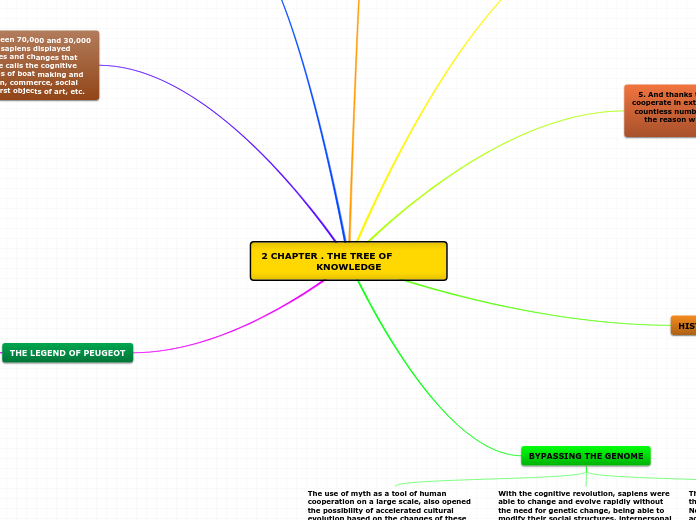2 CHAPTER . THE TREE OF KNOWLEDGE
2. The theory is shared that this revolution began with an accidental genetic mutation that changed the internal connections of the human brain, allowing the development of a totally new type of language. He calls it the mutation of the tree of knowledge.
1. In the period between 70,000 and 30,000 years ago homo sapiens displayed remarkable abilities and changes that constitute what he calls the cognitive revolution. The skills of boat making and navigation, religion, commerce, social stratification, the first objects of art, etc.
3. It mainly analyzes two theories that try to explain the novelty of the new language. One of them appeals to its flexibility based on the combination of multiple sounds and signals to produce an infinite number of sentences. Another defends that language evolved as a variant of gossip given that man is first and foremost a social animal.
4. But the author Yuval Noah Harari argues that the truly differential feature of the new language of sapiens is their ability to transmit information about things that do not exist, that is, to create fictions and believe them. With the cognitive revolution appear the legends, myths, gods and religions. And the fictions have allowed us not only to imagine things, but to do it collectively.
5. And thanks to this ability, sapiens can cooperate in extremely flexible ways with a countless number of strangers, and that is the reason why sapiens dominate the world.
HISTORY AND BIOLOGY
- The imagined realities and the behaviors associated with them we call "culture", and the narration of their evolution we call "history".
- "The cognitive revolution is the point at which history declared the independence of biology."
- From the cognitive revolution, human evolution is not explained only from biology as it had been up to that moment, but through the collective myths that it was able to create.
Can explain the change in the relationship between biology and history after the cognitive revolution:
1) Biology establishes the basic parameters for human behavior.
2) But, with their ability to create fictions, sapiens learn to play an amazing variety of games that are increasingly complex.
3) Therefore, in order to understand how sapiens behave, we must describe the historical evolution of their actions. Biology is no longer enough as an explanation.
BYPASSING THE GENOME
The use of myth as a tool of human cooperation on a large scale, also opened the possibility of accelerated cultural evolution based on the changes of these myths. The example of the French Revolution is given, and as in a moment one goes from believing in the myth of divine right to the myth of the sovereignty of the people. This ability differentiates sapiens from other animals, whose behavior is largely determined by the genes.
With the cognitive revolution, sapiens were able to change and evolve rapidly without the need for genetic change, being able to modify their social structures, interpersonal relationships, economic activities, etc. And this was the key to its success.
Thanks to this ability, they imposed themselves on other human species such as Neanderthals. And they managed to develop activities that no other animal performs, such as trade, which depends on the trust that generate collective myths (today the dollar, the federal reserve or trademarks).
THE LEGEND OF PEUGEOT
The mode of organization of chimpanzee cousins in tropillas between 20 and 50, with an alpha male (a king). It also describes the need for intimate knowledge between each of them in order to be able to form, which limits the number of group members.
With the cognitive revolution and gossip, the sapiens managed to increase the size of the groups. But gossip also has a (natural) limit, and over 150 members it is no longer possible to maintain the unity of the group. With this he could, because Homo Sapiens managed to overcome that barrier thanks to his ability to create shared fictions or common myths.
Churches, states, nations, money, laws, human rights and all our institutions are fictions. It tells the story of the Peugeot company as an example of the fiction of limited liability companies, something lawyers call "legal fiction." The Peugeot logo is the lion of Stadel, a 30,000-year-old statuette. This means that Peugeot is invulnerable or immortal.
On reality as it is perceived, sapiens superimpose an imagined reality and thus live in a dual reality. With the passage of time the reality imagined was becoming more and more a belief, to the point that today the real reality of the rivers and the environment depends on the imagined in the form of gods, nations and corporations.
